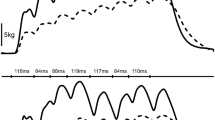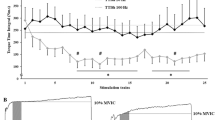Abstract
Previous studies have suggested that during sustained maximal voluntary and evoked contractions, decreasing activation rates may minimize fatigue. The idea of gradually decreasing stimulation frequency to preserve force during fatiguing isometric contractions has, however, recently been challenged. The primary purpose of this study was to test the effectiveness of decreasing or increasing electrical stimulation rates during evoked, repetitive, submaximal, non-isometric contractions of healthy human quadriceps femoris muscles. The ability of the muscles to produce a 50° knee excursion repetitively was evaluated using low-frequency trains, high-frequency trains, and a combination of these trains. Results showed that stimulating the muscles with high-frequency trains followed by low-frequency trains produced the worst performance and starting with low-frequency trains followed by high-frequency trains produced the best performance. Present results cast doubt on the applicability of decreasing stimulation rates during non-isometric contractions and suggest that a combination of trains that begin at a low frequency and then switch to a higher-frequency may improve performance during functional electrical stimulation.





Similar content being viewed by others
References
Adam A, De Luca CJ (2003) Recruitment order of motor units in human vastus lateralis muscle is maintained during fatiguing contractions. J Neurophysiol 90:2919–2927
Barnett S, Cooney K, Johnston R (1991) Electrically elicited quadriceps femoris muscle torque as a function of various electrode placements. J Clin Electrophysiol 3:5–8
Bevan L, Laouris Y, Reinking RM, Stuart DG (1992) The effect of the stimulation pattern on the fatigue of single motor units in cats. J Physiol (Lond) 449:85–108
Bigland-Ritchie BR (1993) Regulation of motorneuron firing rates in fatigue. In: Sargeant AJ, Kernell D (eds) Neuromuscular fatigue. Royal Netherlands Academy of Arts and Sciences, Amsterdam, pp147–155
Bigland-Ritchie B, Jones DA, Woods JJ (1979) Excitation frequency and muscle fatigue: electrical responses during human voluntary and stimulated contractions. Exp Neurol 64:414–427
Bigland-Ritchie B, Johansson R, Lippold OCJ, Woods JJ (1983) Contractile speed and EMG changes during fatigue of sustained maximal voluntary contractions. J Neurophysiol 50:313–324
Bigland-Ritchie B, Johansson R, Lippold OCJ, Smith S, Woods JJ (1983) Changes in motorneuron firing rates during sustained maximal voluntary contractions. J Physiol (Lond) 340:335–346
Bigland-Ritchie B, Cafarelli E, Vollestad NK (1986) Fatigue of submaximal static contractions. Acta Physiol Scand 128:137–148
Binder-Macleod SA, Barrish WJ (1992) Force response of rat soleus muscle to variable-frequency train stimulation. J Neurophysiol 68:1068–1078
Binder-Macleod SA, Lee SCK (1996) Catchlike property of human skeletal muscle during isovelocity movements. J Appl Physiol 80:2051–2059
Binder-Macleod SA, McDermond LR (1992) Changes in the force-frequency relationship of the human quadriceps muscle following electrically and voluntarily induced fatigue. Phys Ther 72:95–104
Binder-Macleod SA, Scott WB (2001) Comparison of fatigue produced by various electrical stimulation trains. Acta Physiol Scand 172:195–203
Binder-Macleod SA, Halden EE, Jungles KA (1995) Effects of stimulation intensity on the physiological responses of human motor units. Med Sci Sports Exerc 27:556–565
Binder-Macleod SA, Lee SCK, Fritz AD, Kucharski LJ (1998) New look at force-frequency relationship of human skeletal muscle: effects of fatigue. J Neurophysiol 79:1858–1868
Burke RE (1981) Motor units: anatomy, physiology and functional organization. In: Brooks VB (ed) Handbook of physiology, vol 2. Williams and Wilkins, Baltimore, MD, pp 345–411
Burke RE, Rudomin P, Zajac FE III (1976) The effect of activation history on tension production by individual muscle units. Brain Res 109:515–529
Chin ER, Allen DG (1996) The role of elevations in intracellular [Ca2+] in the development of low frequency fatigue in mouse single fibers. J Physiol (Lond) 491:813–824
Damiano DL, Martellotta TL, Sullivan DJ, Granata KP (2000) Muscle force production and functional performance in spastic cerebral palsy: relationship of cocontraction. Arch Phys Med Rehabil 81:895–900
Ding J, Wexler AS, Binder-Macleod SA (2000) Development of a mathematical model that predicts optimal muscle activation pattern. J Appl Physiol 88:916–925
Duchateau J, Hainaut K (1986) Nonlinear summation of contractions in striated muscle. II. Potentiation of intracellular Ca2+ movements in single barnacle muscle fibers. J Muscle Res Cell Motil 7:12–24
Edwards RHT, Hill DK, Jones DA, Merton PA (1977) Fatigue of long duration in human skeletal muscle after exercise. J Physiol (Lond) 272:769–778
Enoka RM, Stuart DG (1992) Neurobiology of muscle fatigue. J Appl Physiol 72:1631–1648
Korzeniewski B, Zoladz JA (2003) Training-induced adaptation of oxidative phosphorylation in skeletal muscles. Biochem J 374:37–40
Fitts RH (1994) Cellular mechanisms of muscle fatigue. Physiol Rev 74:49–94
Fuglevand AJ (1996) Neural aspects of fatigue. Neuroscientist 2:203–206
Fuglevand AJ, Keen DA (2003) Re-evaluation of muscle wisdom in human adductor pollicis using physiological rates of stimulation. J Physiol (Lond) 549:865–875
Fuglevand AJ, Macefield VG, Bigland-Ritchie B (1999) Force-frequency and fatigue properties of motor units in muscles that control digits of the human hand. J Neurophysiol 81:1718–1729
Garland SJ, Gossen ER (2002) The muscle wisdom hypothesis in human muscle fatigue. Exerc Sport Sci Rev 30:45–49
Garland SJ, Enoka RM, Serrano LP, Robinson GA (1994) Behavior of motor units in human biceps brachii during a submaximal fatiguing contraction. J Appl Physiol 76:2411–2419
Garland SJ, Griffin L, Ivanova T (1997) Motor unit discharge rate is not associated with muscle relaxation in sustained submaximal contractions in humans. Neurosci Lett 239:25–28
Griffin L, Garland SJ, Ivanova T, Gossen ER (2001) Muscle vibration sustains motor unit firing rate during submaximal isometric fatigue in humans. J Physiol (Lond) 535:929–936
Henneman E, Mendell LM (1981) Functional organization of motor neuron pool and its inputs. In: Brooks VB (ed) Handbook of Physiology, vol 2. Williams and Wilkins, Baltimore, MD, pp 423–508
Jones DA, Bigland-Ritchie B, Edwards RHT (1979) Excitation frequency and muscle fatigue: Mechanical responses during voluntary and stimulated contractions. Exp Neurol 64:401–413
Karu ZZ, Durfee WK, Barzilai AM (1995) Reducing muscle fatigue in FES applications by stimulating with N-let pulse trains. IEEE Trans Biomed Eng 42:809–817
Kebaetse MB, Lee SCK, Binder-Macleod SA (2001) A novel stimulation pattern improves performance during repetitive dynamic contractions. Muscle Nerve 24:744–752
Kebaetse MB, Turner AE, Binder-Macleod SA (2002) Stimulation pattern and frequency affect dynamic shortening contractions. J Appl Physiol 92:109–116
Keppel G (1991) Correction for cumulative type I error. In: Keppel G (ed) Design and analysis: a researcher’s handbook, 3rd edn. Prentice Hall, Upper Saddle River, NJ, pp 163–184
Knaflitz M, Merletti, De Luca CJ (1990) Inference of motor unit recruitment order in voluntary and electrically elicited contractions. J Appl Physiol 68:1657–1667
Kukulka CG, Clamann HP (1981) Comparison of the recruitment and discharge properties of motor units in human brachial biceps and adductor pollicis during isometric contractions. Brain Res 219:45–55
Lee SCK, Binder-Macleod SA (2000) Effects of activation frequency on dynamic performance of human fresh and fatigued muscles. J Appl Physiol 88:2166–2175
Lee SCK, Becker CN, Binder-Macleod SA (1999) Catchlike-inducing train activation of human muscle during isotonic contractions: burst modulation. J Appl Physiol 87:1758–1767
Lewek M, Rudolph K, Axe M, Snyder-Mackler L (2002) The effect of insufficient quadriceps strength on gait after anterior cruciate ligament reconstruction. Clin Biomech 17:56–63
Marsden CD, Meadows JC, Merton PA (1976) Fatigue of human muscle in relation to the number and frequency of motor impulses (abstract). J Physiol (Lond) 258:94–95
Marsden CD, Meadows JC, Merton PA (1983) “Muscular wisdom” that minimizes fatigue during prolonged effort in man: peak rates of motorneuron discharge and slowing of discharge during fatigue. Adv Neurol 39:351–366
Maton B, Gamet D (1989) The fatigability of two agonistic muscles in human isometric voluntary submaximal contraction: an EMG study. Eur J Appl Physiol 58:369–374
Miller KJ, Garland SJ, Ohtsuki T (1996) Motor unit behavior in humans during fatiguing arm movements. J Neurophysiol 75:1629–1636
Russ DW, Binder-Macleod SA (1999) Variable-frequency trains offset low-frequency fatigue in human skeletal muscle. Muscle Nerve 22:874–882
Russ DW, Elliott MA, Vandenborne K, Walter GA, Binder-Macleod SA (2002) Metabolic costs of isometric force generation and maintenance of human skeletal muscle. Am J Physiol 282: E448–E457
Sandercock TG, Heckman CJ (1997) Doublet potentiation during eccentric and concentric contractions of cat soleus muscle. J Appl Physiol 82:1219–1228
Scott WB, Binder-Macleod SA (2003) Changing stimulation pattern improves performance during electrically elicited contractions. Muscle Nerve 28:174–180
Steele DS, Duke AM (2003) Metabolic factors contributing to altered Ca2+ regulation in skeletal muscle fatigue. Acta Physiol Scand 179:39–48
Stein RB, Parmiggiani F (1979) Optimal motor patterns for activating mammalian muscle. Brain Res 175:372–376
Stokes MJ, Edwards RHT, Cooper RG (1989) Effect of low frequency fatigue on human muscle strength and fatigability during subsequent stimulated activity. Eur J Appl Physiol 59:278–283
Thomas CK, Bigland-Ritchie B, Johansson R (1991) Force-frequency relationship of human thenar motor units. J Neurophysiol 65:1509–1516
Westerblad H, Duty S, Allen DG (1993) Intracellular calcium concentration during low-frequency fatigue in isolated single fibers of mouse skeletal muscles. J Appl Physiol 75:382–388
Williams JH (1997) Contractile apparatus and sarcoplasmic reticulum function: effects of fatigue, recovery, and elevated Ca2+. J Appl Physiol 83:444–450
Acknowledgements
This research was supported by the National Institutes of Health grant HD 36797 to Dr. S.A. Binder-Macleod.
Author information
Authors and Affiliations
Corresponding author
Rights and permissions
About this article
Cite this article
Kebaetse, M.B., Binder-Macleod, S.A. Strategies that improve human skeletal muscle performance during repetitive, non-isometric contractions. Pflugers Arch - Eur J Physiol 448, 525–532 (2004). https://doi.org/10.1007/s00424-004-1279-0
Received:
Accepted:
Published:
Issue Date:
DOI: https://doi.org/10.1007/s00424-004-1279-0




